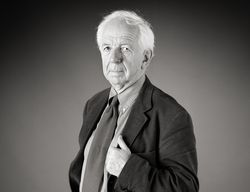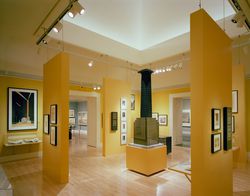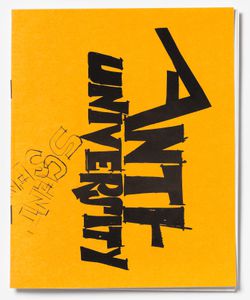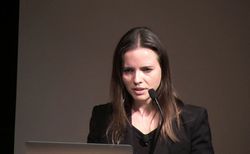graphique
ARCH276741
Description:
Concours du Grand-Prix de Rome d'Architecture, École Nationale des Beaux-Art, Arte Funeraria Italianna, Médailles du concours d'architecture et pages extraites de plusieurs périodiques, dont le Salon de l'Architecture et l'Architecte.
1866 - 1921
Concours européens, École Nationale des Beaux-Arts et reproductions tirés de périodiques
Actions:
ARCH276741
Description:
Concours du Grand-Prix de Rome d'Architecture, École Nationale des Beaux-Art, Arte Funeraria Italianna, Médailles du concours d'architecture et pages extraites de plusieurs périodiques, dont le Salon de l'Architecture et l'Architecte.
graphique
1866 - 1921
Hubert Damisch, chercheur principal et boursier Mellon au CCA en 2003-2004, examine la conséquence qu’aura, pour l’avenir de la pensée structurale, l’édifice-nuage Blur. Créé par la firme d’architectes new-yorkais Diller + Scofidio sur le lac de Neuchâtel en Suisse, cet édifice est la plus récente et radicale expression d’un désir de fluidité et d’évanescence en(...)
Théâtre Paul-Desmarais
8 mai 2003
Hubert Damisch : Effacer l’architecture?
Actions:
Description:
Hubert Damisch, chercheur principal et boursier Mellon au CCA en 2003-2004, examine la conséquence qu’aura, pour l’avenir de la pensée structurale, l’édifice-nuage Blur. Créé par la firme d’architectes new-yorkais Diller + Scofidio sur le lac de Neuchâtel en Suisse, cet édifice est la plus récente et radicale expression d’un désir de fluidité et d’évanescence en(...)
Théâtre Paul-Desmarais
DR1974:0002:013:001-008
Description:
- This album contains large rendered drawings executed by Hubert Rohault de Fleury between 1800 and 1802 for architectural competitions held at the École Spéciale de Peinture, Sculpture et Architecture. These include renderings submitted by him for the 1800 Grand Prix programme for an "École Nationale des Beaux-Arts" (DR1974:0002:013:002 and DR1974:0002:013:008), for which he won a "deuxième Grand Prix", and for the 1801 Grand Prix Programme for "Un forum ou place public dédié à la Paix" (DR1974:0002:013:001 and DR1974:0002:013:007). David Le Roy, professor of architectural theory at the École, has signed and dated all four drawings on the verso, which indicates that the sheets were blank before being completed "en loge" (Levine, 99 and Perouse de Montclos, 11). Drawings DR1974:0002:013:004, DR1974:0002:013:005 (front and rear elevations for the same building), and DR1974:0002:013:006 are probably renderings for either a Grand Prix competition or a "projet rendu". The subject matter depicted in drawings DR1974:0002:013:004 - DR1974:0002:013:006 remains unclear. Bergdoll suggests that the drawings may be for Grand Prix programmes, including a "Ministère des Relations Extérieures" and a warehouse (Bergdoll, "HUBERT ... ", 1985), however, the former is depicted in DR1974:0002:013:007 and is therefore part of the larger 1801 Grand Prix programme for "Un forum ou place dédié à la Paix" (1801). A warehouse complex was never chosen as a Grand Prix programme during 1800-1802, Hubert's student years at the École (Macmillan). A recent Master's thesis suggests that Hubert Rohault de Fleury may have begun his studies at the École des Beaux-Arts in 1798 rather than 1800 (Amouroux, 3), in which case the unidentified drawings could be for the Grand Prix competitions held in 1798 and 1799 for a "Bourse pour une ville maritime" and an "Élysée ou cimetière public". The drawing for a fountain in honour of General Desaix, place Thionville (DR1974:0002:013:003) is possibly an entry for a "Prix d'émulation", in which monuments were a favorite category (Jacques, 61).
architecture
1800-1802
Album of student drawings for architectural competitions held at the École spéciale de peinture, sculpture et architecture, Paris
Actions:
DR1974:0002:013:001-008
Description:
- This album contains large rendered drawings executed by Hubert Rohault de Fleury between 1800 and 1802 for architectural competitions held at the École Spéciale de Peinture, Sculpture et Architecture. These include renderings submitted by him for the 1800 Grand Prix programme for an "École Nationale des Beaux-Arts" (DR1974:0002:013:002 and DR1974:0002:013:008), for which he won a "deuxième Grand Prix", and for the 1801 Grand Prix Programme for "Un forum ou place public dédié à la Paix" (DR1974:0002:013:001 and DR1974:0002:013:007). David Le Roy, professor of architectural theory at the École, has signed and dated all four drawings on the verso, which indicates that the sheets were blank before being completed "en loge" (Levine, 99 and Perouse de Montclos, 11). Drawings DR1974:0002:013:004, DR1974:0002:013:005 (front and rear elevations for the same building), and DR1974:0002:013:006 are probably renderings for either a Grand Prix competition or a "projet rendu". The subject matter depicted in drawings DR1974:0002:013:004 - DR1974:0002:013:006 remains unclear. Bergdoll suggests that the drawings may be for Grand Prix programmes, including a "Ministère des Relations Extérieures" and a warehouse (Bergdoll, "HUBERT ... ", 1985), however, the former is depicted in DR1974:0002:013:007 and is therefore part of the larger 1801 Grand Prix programme for "Un forum ou place dédié à la Paix" (1801). A warehouse complex was never chosen as a Grand Prix programme during 1800-1802, Hubert's student years at the École (Macmillan). A recent Master's thesis suggests that Hubert Rohault de Fleury may have begun his studies at the École des Beaux-Arts in 1798 rather than 1800 (Amouroux, 3), in which case the unidentified drawings could be for the Grand Prix competitions held in 1798 and 1799 for a "Bourse pour une ville maritime" and an "Élysée ou cimetière public". The drawing for a fountain in honour of General Desaix, place Thionville (DR1974:0002:013:003) is possibly an entry for a "Prix d'émulation", in which monuments were a favorite category (Jacques, 61).
architecture
L’américanisme, ce mélange d’idéalisation, de mimétisme et de réprobation qu’inspira aux architectes européens la découverte des modèles urbains et des pratiques de construction venus d’Amérique, constitue le thème de l’exposition Scènes de la vie future : L’architecture européenne et la tentation de l’Amérique, 1893-1960. Les gratte-ciel, les vastes installations(...)
Salles principales
14 juin 1995 au 14 septembre 1995
Scènes de la vie future : l'architecture européenne et la tentation de l'Amérique, 1893-1960
Actions:
Description:
L’américanisme, ce mélange d’idéalisation, de mimétisme et de réprobation qu’inspira aux architectes européens la découverte des modèles urbains et des pratiques de construction venus d’Amérique, constitue le thème de l’exposition Scènes de la vie future : L’architecture européenne et la tentation de l’Amérique, 1893-1960. Les gratte-ciel, les vastes installations(...)
Salles principales
DR1974:0002:012:001-049
Description:
- This album contains student drawings by Hubert Rohault de Fleury executed at the École spéciale de peinture, sculpture et architecture, Paris (1798-1802), including drawings for the Grand Prix Competitions of 1800, 1801 and 1802, the Concours d'essai, the Concours d'émulation of 1800 and 1801, and other undetermined competitions. The drawings illustrate all stages of the design and competition process, ranging from preliminary sketches and esquisses to finished renderings, but do not include the renderings submitted to the Grand Prix Competitions. Drawings for the conversion of the Église de la Madeleine into a Temple de la Gloire (ca. 1806-1807) include line and wash drawings. Hubert's 1800 Grand Prix entry for an École nationale des beaux-arts was awarded the "deuxième Grand Prix" and this album includes: the esquisse; a handwritten copy of the programme; 11 large-scale line drawings - sections, elevations, and details of the ornamentation (DR1974:0002:012:008 R; DR1974:0002:012:012 R; DR1974:0002:012:037, DR1974:0002:012:039, DR1974:0002:012:041 - DR1974:0002:012:049). Two other drawings depict an École des beaux-arts, but they do not conform to the esquisse of Hubert's 1800 Grand Prix entry (DR1974:0002:012:012 V and DR1974:0002:012:013). Hubert's 1801 Grand Prix entry for a forum or public square dedicated to peace, is represented by the esquisse and four elevations, one coloured with wash (DR1974:0002:012:009 R/V - DR1974:0002:012:011 R). Studies of triumphal arches, probably relate to this project (DR1974:0002:012:011 V). Hubert's winning 1802 Grand Prix entry for a public fair with a hall for the exhibition of products of industry located on the banks of a large river is represented by an elevation and sectional elevation for the esquisse; 3 prints; finished plans, one of which is possibly part of the esquisse; elevations; sectional elevations; and one section (DR1974:0002:012:001 R/V - DR1974:0002:012:006 R/V:001-004). Three drawings which are apparently for public fairs are perhaps studies for the 1802 Grand Prix Competition (DR1974:0002:012:007 R:001-003). Also included are Hubert's entries in the Concours d'essai for each of these Grand Prix Competitions. The presence of "devises" on several drawings indicates they are the submitted competition entries: a school or college for the Concours d'émulation of 25 June 1801, for which Rohault de Fleury won a medal, a temple, a lycée, an opera house, a public bath, a sepulchral chapel, and possibly an exchange. An uncharacteristic nocturnal elevation is possibly for a cenotaph dedicated to Isaac Newton (DR1974:0002:012:014). Rohault de Fleury's design for the conversion of the Église de la Madeleine is represented by two plans (one with an elevation) drawn on engraved plans of the Madeleine, three sketch plans, a section, an elevation of a capital and other ornamentation, and an engraved plan of the designs by Pierre Contant d'Ivry and Guillaume Martin Couture for the same project.
architecture, architecture temporaire, urbanisme
drawings executed 1800-1807, manuscripts between 1800 and 1802, published 1806
Album of student drawings for architectural competitions held at the École spéciale de peinture, sculpture et architecture and drawings for the conversion of the Église de la Madeleine into a Temple de la Gloire, Paris
Actions:
DR1974:0002:012:001-049
Description:
- This album contains student drawings by Hubert Rohault de Fleury executed at the École spéciale de peinture, sculpture et architecture, Paris (1798-1802), including drawings for the Grand Prix Competitions of 1800, 1801 and 1802, the Concours d'essai, the Concours d'émulation of 1800 and 1801, and other undetermined competitions. The drawings illustrate all stages of the design and competition process, ranging from preliminary sketches and esquisses to finished renderings, but do not include the renderings submitted to the Grand Prix Competitions. Drawings for the conversion of the Église de la Madeleine into a Temple de la Gloire (ca. 1806-1807) include line and wash drawings. Hubert's 1800 Grand Prix entry for an École nationale des beaux-arts was awarded the "deuxième Grand Prix" and this album includes: the esquisse; a handwritten copy of the programme; 11 large-scale line drawings - sections, elevations, and details of the ornamentation (DR1974:0002:012:008 R; DR1974:0002:012:012 R; DR1974:0002:012:037, DR1974:0002:012:039, DR1974:0002:012:041 - DR1974:0002:012:049). Two other drawings depict an École des beaux-arts, but they do not conform to the esquisse of Hubert's 1800 Grand Prix entry (DR1974:0002:012:012 V and DR1974:0002:012:013). Hubert's 1801 Grand Prix entry for a forum or public square dedicated to peace, is represented by the esquisse and four elevations, one coloured with wash (DR1974:0002:012:009 R/V - DR1974:0002:012:011 R). Studies of triumphal arches, probably relate to this project (DR1974:0002:012:011 V). Hubert's winning 1802 Grand Prix entry for a public fair with a hall for the exhibition of products of industry located on the banks of a large river is represented by an elevation and sectional elevation for the esquisse; 3 prints; finished plans, one of which is possibly part of the esquisse; elevations; sectional elevations; and one section (DR1974:0002:012:001 R/V - DR1974:0002:012:006 R/V:001-004). Three drawings which are apparently for public fairs are perhaps studies for the 1802 Grand Prix Competition (DR1974:0002:012:007 R:001-003). Also included are Hubert's entries in the Concours d'essai for each of these Grand Prix Competitions. The presence of "devises" on several drawings indicates they are the submitted competition entries: a school or college for the Concours d'émulation of 25 June 1801, for which Rohault de Fleury won a medal, a temple, a lycée, an opera house, a public bath, a sepulchral chapel, and possibly an exchange. An uncharacteristic nocturnal elevation is possibly for a cenotaph dedicated to Isaac Newton (DR1974:0002:012:014). Rohault de Fleury's design for the conversion of the Église de la Madeleine is represented by two plans (one with an elevation) drawn on engraved plans of the Madeleine, three sketch plans, a section, an elevation of a capital and other ornamentation, and an engraved plan of the designs by Pierre Contant d'Ivry and Guillaume Martin Couture for the same project.
dessins, documents textuels, oeuvres d'art
drawings executed 1800-1807, manuscripts between 1800 and 1802, published 1806
architecture, architecture temporaire, urbanisme
De 1966 à 1968, Shadrach Woods et Cedric Price, tous deux architectes et professeurs à Paris et à Londres, ont été happés par un tourbillon de changements au sein du monde de l’éducation. Comme l’architecture, le domaine était en quête de nouveaux modèles; les théoriciens cherchaient à reformuler les problèmes de base de l’éducation, plutôt que de simplement proposer de(...)
Maison Shaughnessy Mot(s)-clé(s):
Shadrach Woods, Cedric Price, chercheure en résidence, Federica Doglio
24 juillet 2014, 18h
Séminaire de chercheur en résidence : Federica Doglio
Actions:
Description:
De 1966 à 1968, Shadrach Woods et Cedric Price, tous deux architectes et professeurs à Paris et à Londres, ont été happés par un tourbillon de changements au sein du monde de l’éducation. Comme l’architecture, le domaine était en quête de nouveaux modèles; les théoriciens cherchaient à reformuler les problèmes de base de l’éducation, plutôt que de simplement proposer de(...)
Maison Shaughnessy Mot(s)-clé(s):
Shadrach Woods, Cedric Price, chercheure en résidence, Federica Doglio
5 avril 2018
archives
Niveau de description archivistique:
Collection
Collection Rohault de Fleury
CI001
Résumé:
The Rohault de Fleury collection documents the work of three generations of French architects, Hubert, his son Charles, and his grandson Georges, spanning from the early 18th to late 19th century. The collection is extremely varied encompassing both private and government commissions and including domestic work, institutional buildings, commercial buildings, urban planning, and student work from both the École des beaux-arts and the École polytechnique, and archaeological studies. Stylistically, the projects incorporate the two dominant contemporary directions in French architecture - functionalism as advocated by Jean-Nicolas-Louis Durand and the classicism of the École des beaux-arts.
1717-[1884]
Collection Rohault de Fleury
CI001
Résumé:
The Rohault de Fleury collection documents the work of three generations of French architects, Hubert, his son Charles, and his grandson Georges, spanning from the early 18th to late 19th century. The collection is extremely varied encompassing both private and government commissions and including domestic work, institutional buildings, commercial buildings, urban planning, and student work from both the École des beaux-arts and the École polytechnique, and archaeological studies. Stylistically, the projects incorporate the two dominant contemporary directions in French architecture - functionalism as advocated by Jean-Nicolas-Louis Durand and the classicism of the École des beaux-arts.
archives
Niveau de description archivistique:
Collection 1
1717-[1884]
documents textuels
ARCH186991
Description:
L'école d'architecture du paysage de la Faculté de l'Aménagement de Montréal - talk, correspondence to Prof. Luc Noppen, École d'architecture, Université Laval, Québec (1994)
1994
Papers and Presentations
Actions:
ARCH186991
Description:
L'école d'architecture du paysage de la Faculté de l'Aménagement de Montréal - talk, correspondence to Prof. Luc Noppen, École d'architecture, Université Laval, Québec (1994)
documents textuels
1994
Sous-série
Education
CI001.S2.D1
Description:
Like his father Hubert, Charles Rohault de Fleury also studied at the École polytechnique with Jean-Nicolas-Louis Durand (1820-1821), and at the École des Beaux-Arts (1823-1825), Charles studied under his father and Louis Hippolyte Lebas. The CCA collection contains his printed exercise book from the École polytechnique and an album of drawings of the orders executed at both schools. The printed exercise book (DR1974:0002:001:001-105), primarily dated to 1821, provides an overview of the first year curriculum at the École polytechnique reflecting the emphasis placed on the course in descriptive geometry. The exercises proceed from the simple to the complex; from the analysis of simple shapes to the interpretation of basic architectural elements. Many of the problems have been solved by Charles, and carry the approval seal of his professor. A large engraving included in the album provides a succinct table recording the career paths of graduating students in the various Écoles d'application, a description of the core curriculum, and a historical and chronological outline of the École polytechnique from its inception to 1828. Charles' studies of the architectural orders (DR1974:0002:019:001-033), many of which are copied directly from Charles Normand's 'Nouveau parallele des ordres d'architecture...,' demonstrate the continued application of Durand's methodology applied to typical Beaux-Arts studies. The orders executed at the École polytechnique are pared down to their essential form and porticos are abstracted and grouped according to their tetrastyle, hexastyle, or octastyle configurations, whereas the orders completed at the École des beaux-arts are simplified, but still reflect the traditional mimetic interpretation of classical antiquity, with its fidelity to mouldings and details. The conspicous abscence of the composite order and the addition of the 'Dorique Romain and Moderne', attest to the continued influence of Durand's ''Precis'. The information regarding George's architectural career is limited to twelve drawings for architectural ornament and sculpture (1858-1859) submitted to a newly introduced, and obligatory, 'dessin' Concours d'emulation at the École des beaux-arts (1). (1) R. Chaffe, "The teaching of architecture at the École des Beaux-Arts" in Arthur Drexler ed., 'The Architecture of the École des Beaux-Arts' (New York: MOMA, 1975), p.84 and fn. 120.)
[1776?]-1868
Education
CI001.S2.D1
Description:
Like his father Hubert, Charles Rohault de Fleury also studied at the École polytechnique with Jean-Nicolas-Louis Durand (1820-1821), and at the École des Beaux-Arts (1823-1825), Charles studied under his father and Louis Hippolyte Lebas. The CCA collection contains his printed exercise book from the École polytechnique and an album of drawings of the orders executed at both schools. The printed exercise book (DR1974:0002:001:001-105), primarily dated to 1821, provides an overview of the first year curriculum at the École polytechnique reflecting the emphasis placed on the course in descriptive geometry. The exercises proceed from the simple to the complex; from the analysis of simple shapes to the interpretation of basic architectural elements. Many of the problems have been solved by Charles, and carry the approval seal of his professor. A large engraving included in the album provides a succinct table recording the career paths of graduating students in the various Écoles d'application, a description of the core curriculum, and a historical and chronological outline of the École polytechnique from its inception to 1828. Charles' studies of the architectural orders (DR1974:0002:019:001-033), many of which are copied directly from Charles Normand's 'Nouveau parallele des ordres d'architecture...,' demonstrate the continued application of Durand's methodology applied to typical Beaux-Arts studies. The orders executed at the École polytechnique are pared down to their essential form and porticos are abstracted and grouped according to their tetrastyle, hexastyle, or octastyle configurations, whereas the orders completed at the École des beaux-arts are simplified, but still reflect the traditional mimetic interpretation of classical antiquity, with its fidelity to mouldings and details. The conspicous abscence of the composite order and the addition of the 'Dorique Romain and Moderne', attest to the continued influence of Durand's ''Precis'. The information regarding George's architectural career is limited to twelve drawings for architectural ornament and sculpture (1858-1859) submitted to a newly introduced, and obligatory, 'dessin' Concours d'emulation at the École des beaux-arts (1). (1) R. Chaffe, "The teaching of architecture at the École des Beaux-Arts" in Arthur Drexler ed., 'The Architecture of the École des Beaux-Arts' (New York: MOMA, 1975), p.84 and fn. 120.)
File 1
[1776?]-1868





